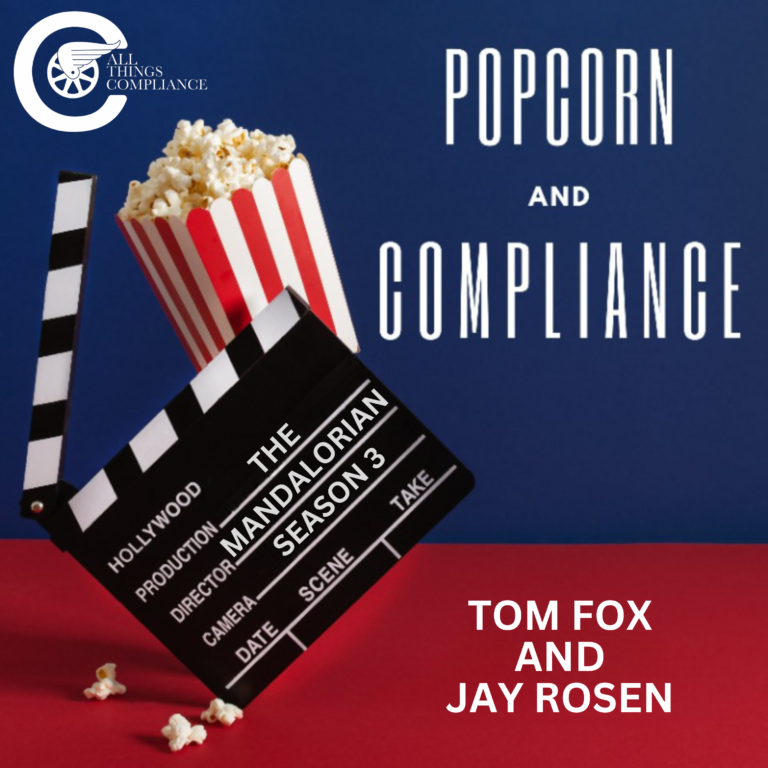Tom Fox and Jay Rosen are back with a special summer season of Popcorn and Compliance. In this special series, Tom and Jay will review the Mandalorian, Season 3. Get ready for a ton of fun, insights and all things Grogu and Mandalorian.
Tom and Jay begin by discussing the long gap between seasons and the main character’s journey after losing his Mandalorian status. The hosts praise John Favreau’s stewardship of the series, which strikes a balance between nostalgia and innovation within the Star Wars universe. They appreciate Favreau’s ability to create different adventures and storylines while paying homage to the franchise’s roots. The conversation also touches on the artwork in each episode, suggesting the idea of a coffee table book featuring stills and drawings. The use of archetypes in Western films is explored, highlighting their importance in storytelling and their presence in “The Mandalorian.” The hosts express admiration for Favreau’s work and discuss plot developments in the series.
Key Highlights
1. The Long-Awaited Return. For fans eagerly anticipating the third season, the long gap between seasons two and three may have left us feeling a bit puzzled. However, as we delve into the first episode, it becomes clear that the wait was well worth it. The story sets up a thrilling journey for the main character, who must regain his status as a Mandalorian.
2. The Anthology Nature of “Star Wars”. Drawing parallels to the anthology nature of “Star Wars,” Jay compares the episode to a series based on “Planet of the Apes.” This approach allows for fresh perspectives and diverse storylines within the Star Wars universe, capturing the essence of what makes this franchise so captivating.
3. Impressive Fight Scenes and Mandalorian Culture. One of the standout moments in the episode is the breathtaking fight scene with a reptilian creature. The Mandalorians showcase their remarkable weapons and skills, instantly captivating viewers. The armorer’s introduction of the phrase “this is the way” has even made its way into the Fox household, a testament to the show’s memorable impact.
4. Controversy and Exceptional Acting. The conversation takes a turn as the removal of actress Gina Carano from the show is discussed. Both Jay and Tom hosts acknowledge Carano’s commendable performance. Furthermore, they delve into the remarkable acting skills of a former MMA star, who brings a unique level of authenticity to her character.
5. Archetypes and Constructive Storytelling. Tom and Jay explore the use of archetypes in movies, citing John Ford westerns and Sergio Leone’s spaghetti westerns as examples. They discuss how these constructs and characters benefit the audience’s understanding and provide a sense of familiarity. The conversation also touches upon the humorous transition from IG 11 to IG 12.
6. Jon Favreau’s Stewardship and Marvel Connections. The hosts commend Jon Favreau’s remarkable work on “The Mandalorian” and his ability to create a new universe within the Star Wars franchise. Drawing comparisons to Kevin Smith’s involvement, they discuss Favreau’s portrayal of Happy in the Marvel Cinematic Universe, highlighting the differences between the character and Favreau’s real-life persona.
7. The Artistic Marvel of “The Mandalorian”. The stunning artwork at the end of each episode is a visual feast for fans. Tom and Jay express their desire for it to be released as a book, even suggesting self-publishing on platforms like Amazon. They also praise the storyboard artists for their contribution to the fantastical universe created in the series.
8. The Growing Republic and Bo Katan’s Significance. The conversation delves into the structure of the new republic and the growing pains experienced by Navarro. The introduction of the high magistrate, played by Carl Weathers, adds depth to the storyline. Bo Katan’s role as a significant player in the series, born into the royal family of Mandalore, becomes increasingly prominent as the series progresses.
9. Favreau’s Budget and Spectacular Fights. Favreau’s seemingly unlimited budget for special effects and fight scenes is evident in the series. The hosts describe the last two fights as exhilarating blowouts, leaving us on the edge of our seats. They also touch upon the use of blue screens for filming, highlighting the freedom Favreau has to create different adventures for the main character.
“The Mandalorian” continues to captivate audiences with its compelling storytelling, memorable characters, and breathtaking visuals. Jon Favreau’s stewardship of the series strikes a perfect balance between nostalgia and innovation, leaving fans eagerly anticipating each new episode. As we eagerly await the next installment, titled “The Mines of Mandalore,” let’s celebrate the remarkable journey this show has taken us on so far.
This is The Way!



